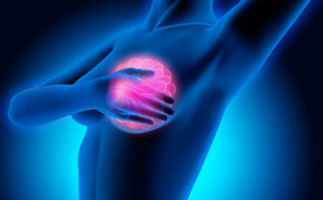
George Washington University researchers have identified a key molecule in certain kinds of breast cancers that prevent immune cells from entering tumours and killing the cancer cells inside.
The paper and its findings, published today in Nature, could pave the way toward a new treatment for certain kinds of aggressive breast cancer.
“During cancer progression, this molecule, known as DDR1, organizes a high-order extracellular matrix that acts like barbed wire around the boundary of a tumour to prevent immune cells from entering the tumour,” Rong Li, the Ross Professor of Basic Science Research at GW and lead author of the paper, said. “Knowing that the DDR1 molecule creates a protective boundary around tumours, we were able to use pre-clinical models to show that the moment you deactivate DDR1, immune cells can infiltrate the tumour and kill the cells inside.”
Li and his colleagues studied triple-negative breast cancer, an aggressive form of cancer that accounts for about 15% of all breast cancer cases.
This type of cancer, according to the Centers for Disease Control and Prevention, lacks the receptors commonly used in targeted cancer therapies, making it difficult to target the tumour cells. Immunotherapy is designed to activate immune cells when they can get to the centre of a tumour, but the DDR1 molecule puts up a physical barrier to anti-tumour immune cells.
Identifying the underlying mechanism could provide a new way of looking for novel therapeutic agents for this hard-to-treat cancer, Li said.
In the Nature study, the researchers assessed the impact of removing DDR1 in multiple pre-clinical models.
They determined that knocking out DDR1 not only halts tumour growth, but it also may protect the body from future tumours.
In conjunction with the new findings, co-corresponding author Zhiqiang An has developed a therapeutic DDR1-targeting antibody that breaks down that line of defence and helps tumour-killing immune cells cross.
“The discovery of the important role of DDR1 in cancer resistance is a significant advance that can potentially transform treatment pathways,” said An, who serves as director of the Texas Therapeutics Institute and a professor of molecular medicine at The University of Texas Health Science Center at Houston (UTHealth Houston). “I’m delighted by the collaboration between researchers and academic labs, excited by synergies of basic and translational research, and encouraged by the rapid translation from discovery to therapeutic candidates for the benefit of people living with cancer.”
With this more comprehensive understanding of DDR1, researchers also hope to identify additional molecules like DDR1 and use the same approach to fight other cancers.
Source: George Washington University
We are an independent charity and are not backed by a large company or society. We raise every penny ourselves to improve the standards of cancer care through education. You can help us continue our work to address inequalities in cancer care by making a donation.
Any donation, however small, contributes directly towards the costs of creating and sharing free oncology education.
Together we can get better outcomes for patients by tackling global inequalities in access to the results of cancer research.
Thank you for your support.